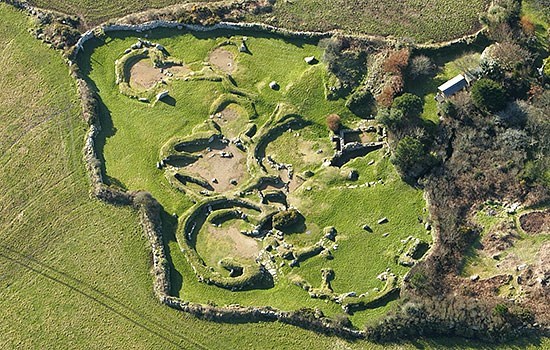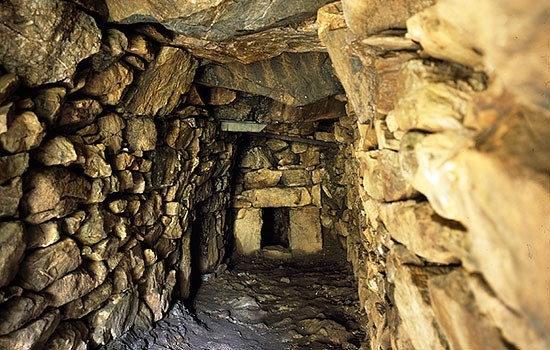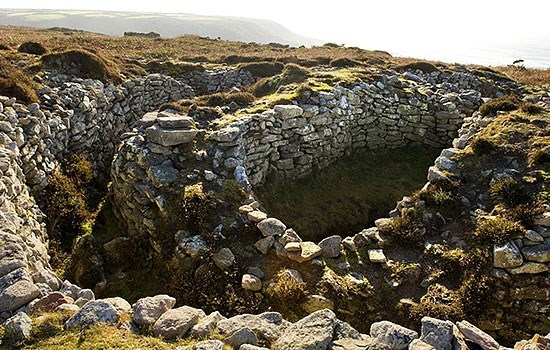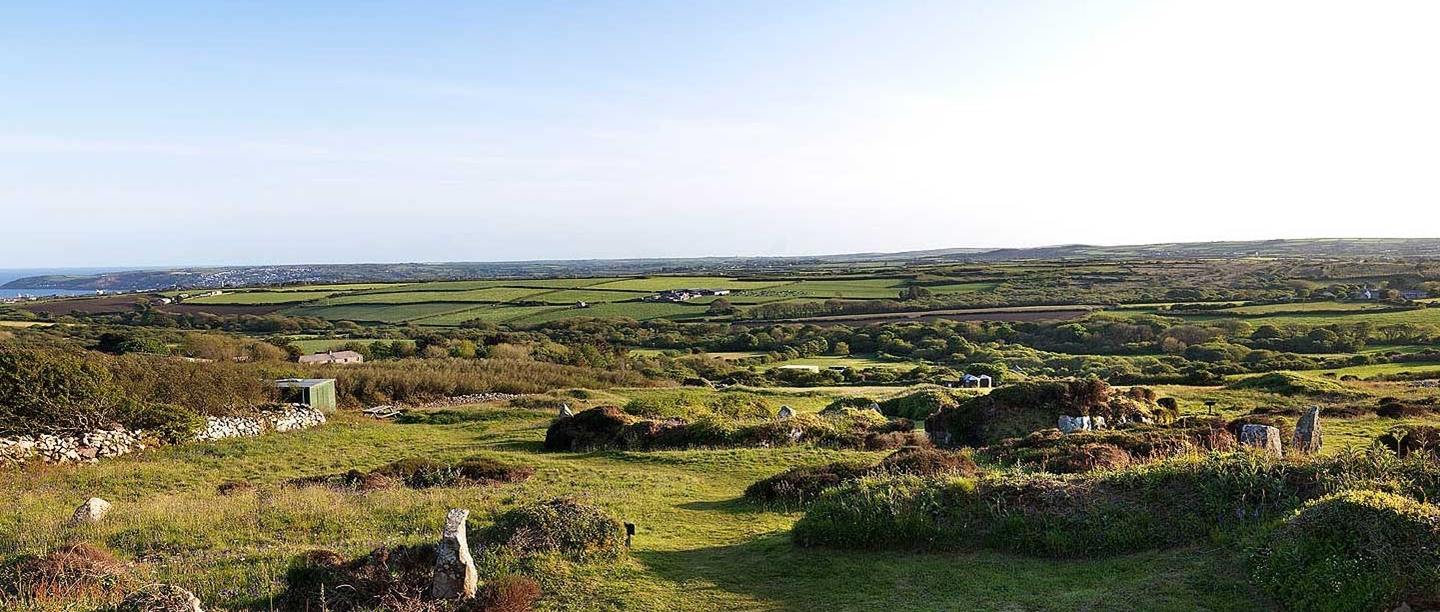Chysauster’s Origins
Although the courtyard houses at Chysauster were built in the Romano-British period, the settlement probably has its origins in the middle Iron Age (from about 400 BC), and occupation in the surrounding area is likely to have begun much earlier. Aerial photography and field surveys have revealed the remnants of prehistoric field systems and associated small round houses in the landscape, probably dating from the Bronze Age (2300–800 BC).
In the Iron Age, the settlement pattern in West Penwith (the westernmost part of Cornwall) seems to have shifted from scattered, isolated houses to villages like Chysauster.
Find out more about life in Prehistoric BritainRomano-British Cornwall
With the start of Roman occupation in Britain in AD 43, Iron Age communities in southern and central Britain had to adapt to military rule, a shift to urban living and a monetary economy, including taxes. Life in the far south-west, however, continued more or less unchanged. Although the Roman road system did extend into Cornwall, only three Roman forts and one villa are known. The nearest Roman administrative centre was at Isca Dumnoniorum, present-day Exeter.
The ten courtyard houses known at Chysauster may equate to ten extended families, so perhaps 50 to 70 people lived here at the village's peak. They would have spoken a Celtic language, probably an early form of Cornish, and were called the Dumnonii by the Romans, although it is not clear what they called themselves. Later the people in this area were known as the Cornovii, a tribal name preserved in the name of Cornwall.
Chysauster seems to have been abandoned in the 3rd century. We do not know why – there is no sign of any violence or conflict. However, by this time, people in Cornwall were more often living in 'rounds' – small defended settlements enclosing several round houses. Up to 100 rounds are known in West Penwith alone.
Learn more about Roman BritainLife in the Village
Chysauster was surrounded by fields, where the inhabitants grazed their flocks of sheep and grew cereal crops. The field boundaries have survived for 2,000 years as low walls and earthworks.
The village is laid out on top of a series of field lynchets, probably dating to the late Iron Age. Lynchets are ridges created by the build-up of soil along the lower boundary of a field when it is ploughed. These long fields were divided into smaller plots, creating the characteristic brick-shaped fields of this period.
Closer to home, people probably used their garden plots to grow vegetables and keep pigs. The villagers may have been involved in tin-streaming, using stream water to separate tin ore from sediments. The tin may have been exchanged or exported, along with woollen cloth and agricultural produce.
It is likely that a network of trusted chiefs organised trade in tin and agricultural produce from a series of local centres, including defended hillforts and coastal cliff castles. The larger courtyard house settlements often seem to be found near one of these small hillforts – Chysauster lies less than a mile west of the impressive hillfort of Castle-an-Dinas.
Below: A reconstruction drawing showing the village as it may have looked at its peak, in the 2nd and 3rd centuries AD
© Historic England/English Heritage Trust (illustration by Peter Urmston)
Courtyard Houses
Courtyard houses are a unique type of dwelling found only in the far west of Cornwall and on the Isles of Scilly. About 45 settlements with this form of house are known. Chysauster is one of the largest and best preserved. Its ten courtyard houses are mostly laid out in two rows, each with a garden plot beside it. This orderly layout may have resulted from the fact that the houses were built on top of two pre-existing agricultural terraces, rather than a deliberate attempt to create a 'village street' arrangement.
At Chysauster the houses are all detached, discrete units, unusual among Cornish settlements of this period which usually have interlocking or conjoined houses.
Courtyard houses date from the Romano-British period (about AD 43–350) but are often on the site of earlier, Iron Age settlements. They are found singly, or in clusters of up to ten houses, as at Chysauster. Often the settlements also include simpler stone round houses, as well as garden plots and associated fields.
The Fogou
South of the houses at Chysauster lie the remains of a fogou – a term derived from the Cornish word for a cave. As the name implies, fogous are stone-built underground tunnels, usually with a long passage and sometimes a chamber. They are distinctive monuments found only in the far west of Cornwall – there are 15 definite fogous, including Halliggye and Carn Euny, and another ten possible examples. Most were built during the later Iron Age (about 400 BC–AD 43).
The original purpose of fogous is unknown. Traditionally they have been interpreted as storehouses for food or valuables, or as refuges to be used during times of conflict. However, it is more likely that they had a ritual or ceremonial purpose of some kind.
The fogou at Chysauster was described as partly destroyed in 1865, with further damage recorded in 1938. It remained accessible to visitors until 1986, when the structure became unstable and a grille was installed. It has never been excavated, so its original size and shape remain unknown.
Read more about the Fogou at Carn EunyLater History and Excavations
After being more or less abandoned for hundreds of years, the village of Chysauster began to attract antiquarian interest in the mid-19th century, when the first plan of the site was published. Explorations of individual houses took place in 1873 and 1897, the first led by William Copeland Borlase, who excavated many prehistoric sites in Cornwall.
The first modern excavations took place in the 1920s and 1930s. Chysauster's appearance today is largely owed to the archaeologist CK Croft Andrew, who recorded and repaired many of the houses in the late 1930s.
Find more Property HistoriesNearby Prehistoric Places to visit
-

Carn Euny Ancient Village
Like Chysauster, Carn Euny was occupied from the Iron Age until late Roman times. It also has an intriguing fogou.
-

Halliggye Fogou
This fogou is the largest and best-preserved of the mysterious underground tunnel complexes associated with Cornish Iron Age settlements.
-

Ballowall Barrow
In a spectacular cliff-edge position, this unique Bronze Age tomb had a long and complex history as a sacred site.

